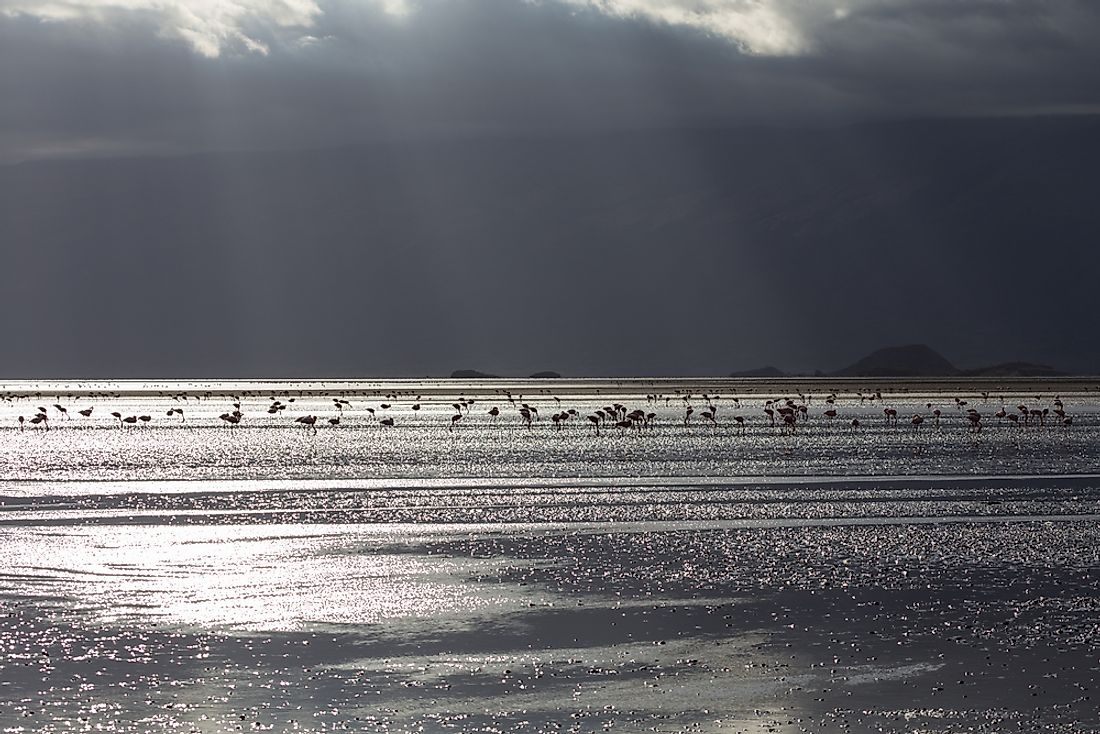What is a Soda Lake?

A soda lake is a lake with a pH value of more than the usual measure of 6 or 7, usually between 9 and 11. High carbonate concentration, especially sodium carbonate, is responsible for the alkalinity of the water. A soda lake may also contain a high concentration of sodium chloride and other salts making it saline or hypersaline Lake. Soda lakes are highly productive ecosystems compared to the freshwater lakes with a global primary production rate of over 10 grams carbon per square meters per day. Soda lakes are therefore the most productive aquatic environment on Earth because of the availability of dissolved carbon dioxide. Soda lakes occur naturally in both arid and semi-arid areas.
Geology And Biodiversity Of Soda Lakes
Geology And Genesis Of Soda Lakes
Geological, climatic, and geographic requirements are required for a lake to become alkaline. A topography that limits the outflow of water from the lake is needed. An endorheic basin is formed when the water is confined without the outflow. The pH of the water in the depression rises through the evaporation of the lake which requires suitable climate like the desert climate to balance between the inflow and evaporation. The rate at which carbonate salt dissolve in the lake water depends on the ecology of the surrounding area. The relative absence of magnesium and calcium is critical in the formation of the soda lake since magnesium or calcium is likely to dissolve quickly and displace the carbonate ion thus neutralizing the PH of the lake water.
Biodiversity Of Soda Lakes
Soda lakes are inhabited by a rich diversity of microbial life making them a productive ecosystem. Soda lakes are permanent and seasonal habitat for algae which are visible in many of the lakes. The colors of the algae vary between lakes depending on their life form. Soda lakes are dominated by prokaryotes like bacteria and archaea, especially in lakes with higher levels of alkalinity. Multicellular organisms such as brine shrimp and fish are found in plenty if not most of the soda lakes. The microorganisms in soda lakes are good sources of food for some of the animals including flamingo and other birds. Soda lakes also harbor unique species which are adapted to the alkali conditions. These organisms which are adapted to the high alkalinity are called haloalkaliphiles. Many endemic microbial species exist in soda lakes unique to individual lakes.
Examples Of Soda Lakes
Africa and Asia have the highest number of soda lakes since the two continents have vast desert conditions which are perfect for the formation of soda lakes. Most of the soda lakes in Africa are located in Eastern Africa, especially in Kenya, Tanzania, and Ethiopia. Some of the soda lakes in Africa include Wadi El Natrun, Lake Basaka, Lake Turkana, Lake Natron, and Lake Ngami. Lake Natron in Tanzania is one of the most outstanding soda lakes in Africa because of the high PH of water which is always about 12. The lake is a regular feeding ground for the majority of the 2.5 million East Africa’s lesser flamingos. India and China have the highest number of soda lakes in Asia. Some of the soda lakes in Asia include Lake Van, Tso Kar Salt Lake, Pangong Salt Lake, and Lake Zabuye. Qinghai Lake in China is the largest soda lake and also the largest lake in China with a PH value of 9.3. About 23 rivers and streams empty into Qinghai Lake with the majority of the stream carrying freshwater.
List of Soda Lakes
| Rank | Lake Name | Location | pH |
|---|---|---|---|
| 1 | Lake Turkana | Kenya | 10.5 |
| 2 | Lake Nakuru | Kenya | 9.2 |
| 3 | Lake Natron | Tanzania | 10.5 |
| 4 | Lake Bogoria | Kenya | 10.5 |
| 5 | Lake Van | Turkey | 9.8 |
| 6 | Lonar Lake | India | 10.5 |
| 7 | Qinghai Lake | China | 9.3 |
| 8 | Lake Zabuye | China | 10 |
| 9 | Lake Neusiedl | Austria, Hungary | 9.3 |
| 10 | Mono Lake | United States | 9.8 |











